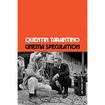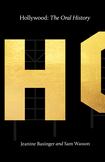

The film industry is passing through one of its recurrent obsessions with cinematic education. Steven Spielberg’s imminent The Fabelmans concerns a young stand-in for the director escaping to the movies in Arizona of the 1950s. Kenneth Branagh did something similarly autobiographical in Belfast. What better time for Quentin Tarantino to walk us through his own already semi-legendary childhood?
The director has been touching on that past since he broke through with the still-thrilling Reservoir Dogs in 1992. The origin myth goes that, while the rest of us were tucked up with The Wombles, Tarantino was accompanying his mom and her dates to the violent, sexually explicit films that hardened his later directorial aesthetic.
Classics of post-classical Hollywood alternated with brash exploitation flicks. One night it was The French Connection. The next it was Five Fingers of Death. Early on in this chatty, hugely enjoyable book, the young Quentin asks Connie, his mom, why he is the only boy in school allowed to see this stuff. “Quentin, I worry more about you watching the news. A movie’s not going to hurt you,” she replied. The grown author interjects with: “Right f**king on, Connie!”
Never boring, always poking you with an insistent finger, Cinema Speculation is at its best in those framing autobiographical sections. The long opening chapter, titled Little Q Watching Big Movies, begins with a trip to see John G Avildsen’s Joe and Carl Reiner’s Where’s Poppa? at the Tiffany cinema on the Sunset Strip in 1970. “Right from the get-go when George Segal puts on a gorilla suit and Ruth Gordon punches him in the nuts, this movie had me,” he says of the Reiner film. “For life,” readers will drily mutter.
‘Forget about glamour’: Jonathan Anderson offers advice to would-be fashion designers as he receives TCD honour
Death of Pope Francis: Derek Mooney leads RTÉ’s coverage to intermittently jaw-dropping effect
Chob Thai restaurant, Clontarf: The most memorable thing here is the bill
Careless People: The controversial book is shocking and reveals Facebook is far worse than we could have suspected
From the start, he presses home how involved he was with black culture. Many of his single mom’s boyfriends were African-American. The most formative of all his early cinemagoing experiences seems to have been a trip to see Jim Brown, former American football player, in the action thriller Black Gunn at a noisy cinema in Compton. He raves: “I’ve spent my entire life since then both attending movies and making them, trying to re-create the experience of watching a brand-new Jim Brown film, on a Saturday night, in a black cinema in 1972.”
Then again, who are we to dictate which cinematic madeleines should tickle his own memory buds?
Some may feel he is trying too hard to push back against the controversies that have repeatedly bubbled up concerning his depiction of black characters — notably his films’ promiscuous use of the n-word. But, whatever else you may say about Quentin Tarantino, his sincerity is never in question. He has the passion of an evangelist.
The main body of the book takes up essays — is “lectures” a better word? — on favourite films from his foundational years. The predictability of the titles is a tad disappointing. Dirty Harry? Check. Bullitt? Check. Rolling Thunder? Check. Though Peter Bogdanovich’s Daisy Miller gets a reappraisal, these are largely the male-oriented action flicks you’d expect in such a volume. Then again, who are we to dictate which cinematic madeleines should tickle his own memory buds?
There is no overriding thesis here, but the format allows Tarantino to tease out a catalogue of diverting arguments. Those supporting the current, puzzling wave of nostalgia for Hollywood of the 1980s will be infuriated to read him again contend the era was among the weediest in the medium’s history. There are brief asides about his own contribution to bloody revival in the 1990s, but he looks to have left that story — which can’t help but involve the entirely unmentioned Harvey Weinstein — largely for future volumes.
A fascinating sidebar may, initially, give the impression he is standing up for current exhausting superhero fans who feel “biased so-called critics” have it in for Marvel and DC. “It would appear most critics writing for newspapers and magazines set themselves up as superior to the films they were paid to review,” he writes. But his encomium to “Second-String Samurai” Kevin Thomas, long the support critic of the Los Angeles Times, celebrates a man who sought out low-budget exploitation flicks that had as little to do with the Hollywood machine as did the most obscure Yemeni folk drama.
His comparison of François Truffaut to schlock-meister Ed Wood is hilarious. His argument that celebrated post-classical cinema left many older audience members behind is worth heeding. But none of this is quite so engrossing as the closing celebration of another black man who helped form the adult Tarantino. In recent weeks, among more serious infractions, Kanye West has alleged that Tarantino “got the idea” for Django Unchained “from me”. The director here reveals that earliest inspiration for that 2012 western actually came from a long-vanished script written by one Floyd Ray Wilson, a former boyfriend of his mother who became a regular cinemagoing companion. His regret at not thanking his old chum, now long dead, at the Oscars provides a moving close to a consistently entertaining volume.
The thrilling opening section relates how a rag-bag of hopefuls drifted west to an underpopulated corner of southern California
One is left wanting more. Well, Tarantino makes a fleeting appearance in Jeanine Basinger and Sam Wasson’s enormous, essential and occasionally infuriating Hollywood: The Oral History. Set loose on the American Film Institute’s archive, making particular use of the Harold Lloyd Master seminars, the authors have assembled a polyphonic tribute to the rise, fall, rise again and maybe final fall of a defining American institution. Quotations from the likes of Bette Davis, Howard Hawks, Alfred Hitchcock and many, many more (a cast of thousands?) are cunningly arranged to create an apparently continuous epic in three, differently sized acts.
The thrilling opening section relates how a rag-bag of hopefuls drifted west to an underpopulated corner of southern California and conjured an art and an industry from spit, sunshine and raw talent. The main body teases out Hollywood’s dynamics during the hegemony of the often-derided studio system. A mournful coda struggles to be optimistic about blockbuster economics and the decline of theatrical exhibition.
In that busy first part, Charlton Heston explains how Cecil B DeMille almost set up shop in a then-smallish Arizona town before, deterred by inclement weather, continuing on to California. “It if hadn’t been raining in Flagstaff, ‘Hollywood’ would now be ‘Flagstaff,’” DeMille’s Moses explains. The pioneers that first settled among the orange groves weren’t trained in cinema. How could they have been? The medium didn’t yet exist. Frank Capra, who went on to direct It’s a Wonderful Life, was an engineer. The costume mistress Edith Head, eventual winner of more Oscars than any other woman, “planned to be a language teacher”. The book brings these people together in a scarcely believable rush of activity that turns vaudeville comics into millionaires overnight.
Early on, when DW Griffith arrives on the scene, we encounter a reminder that this is a contemporaneous oral history, almost entirely unmediated by current sensitivities. The director of the racist The Birth of a Nation is now invariably introduced with a volley of apologies and a downplaying of his contribution to the medium. He is here treated as a deity. The great director Rouben Mamoulian speaks of “birth of an art”. In 1927, a little over a decade after The Birth of a Nation’s premiere, the arrival of sound upended many of the freshly minted conventions. “Just when we were getting it right, it was over,” Peter Bogdanovich recalls Charlie Chaplin remarking.
What follows is the exploration of a world as fantastic as anything in Lord of the Rings. Studios such as MGM and Warner Bros functioned as city states, as empires, as fiefdoms. In the days before location shooting was commonplace, simulacrums of the world’s most beautiful and appalling locales were erected at dazzling speed. If your tooth hurt there was a company dentist. If you got in trouble with the law, the publicity teams would tidy the news away. This invaluable book provides detailed studies of the moguls, enlightening sketches of the stars and — for the real fanatics — rigorous breakdowns of how cameramen, production designers and make-up artists went about their tasks. We learn about Judy Garland’s imposter syndrome. Among several shocking asides on Marilyn Monroe, the screenwriter and director Nunnally Johnson describes her as “downright rude in a kind of stupid way”. In contrast, those raised on the monstrous depiction of Joan Crawford in Mommie Dearest will be surprised to encounter a caring, universally adored professional. “She was terribly charming and sweet,” the director Irving Rapper notes.
The opening half of George Cukor’s A Star is Born pushes Judy Garland’s protagonist through an exhausting and ruthless reinvention by the studio
Olivia De Havilland and Bette Davis are here to explain how they fought to break the studio’s contractual clench on their careers. But the prevailing tone is one of celebration. The opening half of George Cukor’s A Star is Born pushes Judy Garland’s protagonist through an exhausting and ruthless reinvention by the studio, but that director looks back with scarcely qualified affection. “You had enormous and sympathetic help, and that had a lot to do with the success of cinema,” Cukor remembered.
It is understandable that the authors have not cluttered up the page with dates, but one is often frustrated at not knowing when the words were spoken. (That they have issued such a comprehensive tome with no index is less forgivable.) Barely a page goes by without some actor or director noting that the entire business has gone to pot. But is “now” Hollywood’s puzzled 1960s? Are we in its crass 1980s? Checking death dates, it becomes clear many such denunciations are issued in the early 1970s — now one of the most celebrated periods in Hollywood history. “I just go and laugh and throw up,” Katharine Hepburn says derisively of films such as A Clockwork Orange.
That era whizzes past and, by the book’s close — with, as in the Tarantino book, barely a mention of Harvey Weinstein — we are in the still-uncertain present. Poignantly, the volume ends as it began with professionals listing their original job choices. Director Penny Marshall wanted to be a vet. Producer Brian Glazer was a law clerk. But nobody, in the streaming aeon, could plausibly argue that the original cowboy spirit remains. “The movies somehow always survive,” producer David Picker says on the last page. Is that a prediction or a prayer?
Further reading
A handful of bullet-stopping novels wind fascinating histories of the movies — true or alternative — in with their gripping narratives. Few juggle those twin tasks more adroitly than William Boyd’s The New Confessions (1987). The lengthy tome takes a Scottish egoist from the first World War to the thrills of the Weimar film world and on to the compromises of Hollywood in the McCarthy era. Bernard Levin felt it so convincing he found himself rifling through the text for the photographs. David Thomson’s great Suspects (1985) does something quite different — imagining and interweaving the wider lives of movie characters such as Norma Desmond from Sunset Blvd and George Bailey from It’s a Wonderful Life. But the great novel of the cinema is surely Theodore Roszak’s swirling, busy, extravagant Flicker (1991). The somewhat undervalued novel follows an obsessive film nerd as he investigates the life of a near-forgotten German expressionist. Film as narcotic. Film as vocation. Film as ideology. It is all there in a hurtling saga.















